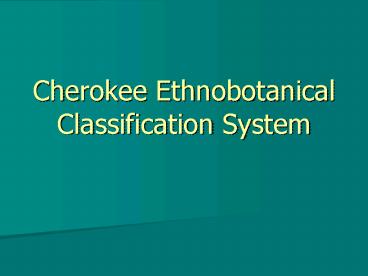Cherokee Ethnobotanical Classification System - PowerPoint PPT Presentation
1 / 38
Title:
Cherokee Ethnobotanical Classification System
Description:
Glean meanings from portions of other names. Reconstruct the name from the components ... Opaque name has no other meaning than the object in hand, unanalyzable, ... – PowerPoint PPT presentation
Number of Views:232
Avg rating:5.0/5.0
Title: Cherokee Ethnobotanical Classification System
1
Cherokee Ethnobotanical Classification System
2
An Historical Ethnobotany
- Constructed from Ethnographic sources
- James Mooney
- Primary source of classification material
- May 10, 1889 to get at the Cherokee basis of
classification
3
Five Aspects
- Cherokee name
- Gloss for the Cherokee name
- Botanical species
- Place in the Ethnobotanical Classification System
- Cultural Association
- Medicinal, edible, and symbolic relationships
4
Whats in a Name?
- Cherokee a changing language in 19th and 20th
Centuries - No continuity
- Phonetic styles were different among the various
researchers - Researchers used phonetic spellings, not Sequoyan
syllabary
5
(No Transcript)
6
Determining Glosses
- Compare the glosses various researchers
- Glean meanings from portions of other names
- Reconstruct the name from the components
7
Verify the Botanical Species
- Is there a voucher specimen?
- Herbaria not set up to find individual specimens
or collections of individual researchers.
8
Does it grow in the region?
9
Does the Cherokee name describe the species in
question?
- Olbrechts
- tsâliyústi gígagéi (like tobacco, red)
- Lobelia siphilitica
10
- Mooney
- Lobelia cardinalis
11
Cherokee Ethnobotanical Classification System
12
Kingdom
- The most inclusive rank in an ethnobiological
system - it contains a single member, but all others are
automatically included (ex plant, animal, fungi) - sometimes referred to as the unique beginner
13
- The plant kingdom is alluded to in the Cherokee
system, but not discretely evident - Each Tree, Shrub, and Herb, down even to the
Grasses and Mosses, agreed to furnish a cure for
some one of each of the diseases named
(Mooney, Myths)
14
Life Form
- A small group of highly inclusive terms that
represent a few shared gross morphological
characteristics - Are polytypic (contain more than one member) and
include the majority of taxonomic categories of a
lesser rank - Plants tree, shrub, herbaceous, grass etc.
- Animal mammal, insect, bird, reptile, fish,
amphibian, etc.
15
There appeared to be several life forms extant in
the Cherokee Ethnobotanical system
- Tree
- Shrub
- Vine
- Herbaceous (non-woody)
- Grass
- Fern
- Moss
- Lichen
16
Tree - Tlukûi
17
Handy Concepts
- Opaque name has no other meaning than the
object in hand, unanalyzable, suggesting a long
cultural history and loss of original meaning
(ex oak) - Transparent name the name expresses the
qualities of the organism through terms with
other meanings, it can be analyzed (ex bluebird)
18
- 67 of tree names were opaque (33 of 49)
- Shrubs and Vines 34
- Herbaceous plants 11
19
Intermediate categories
- generally identified by a primary name that
indicates a salient (prominent) feature, usually
morphological similarities, shared by a number of
often unrelated biological genera
20
Cherokee Intermediate Categories
- shared coloration of plants or plant parts
- plants that change in color due to mechanical
manipulation - plants having a strong odor
- a shared mechanical feature (burrs)
21
únistilû?isti
- they stick flat to a hairy substance
- memory retention, memories sticking just as the
burs stick to a hairy substance
22
Folk Genus (Generic)
- typically includes the largest number of folk
categories and tends to correspond most closely
to the biological species level
23
Characteristics of Folk Genera
- Consistently labeled (given names) in folk
biological taxonomies - Usually included in a life form category (this
is a type of X) - Typical folk classification systems will consist
of approximately 80 monotypic genera (no further
subdivisions)
24
- The Cherokee system appears to be atypical, 67
monotypic genera - Possibly due to the high number of specialists
interviewed
25
Generic names
- Organoleptic qualities
- Visual properties
- Smell
- Taste
- Touch
- Sound
26
- Magnolia fraseri was called tsugwalâga tsegwa or
big leaves, because leaves are up to ½ meter in
length
27
- Oxalis tsuntsâ?ysti (it is sour)
28
Cherokee-ization
- Coffee became káwi (no f sound in Cherokee
language)
29
Onomatopoeia
- Cirsium altissimum known as tsítsi, the sound of
a blow gun dart.
30
Prototypes
- Prototypes are those organisms that are the best
recognized examples of the category - Prototypes are generally at the generic and
subgeneric levels, but can also be at the
intermediate level
31
- yû or ya added to a word to indicate true or
real type - Desmodium nudiflorum
- únistilû?isti-yu
32
Perceptual Relationship (Resemblance)
- iyústi (like or as)
- Oenothera fruticosa
- atátsû? (trout)
33
- Oenothera biennis
- atátsû?-iyústi (like atátsû?)
34
Specific and Varietal
- Specific and varietal taxa are generally labeled
with secondary lexemes, labels that modify the
primary lexeme of the generic label or name - Examples
- Oak (folk genus)
- White Oak (folk species)
- Swamp White Oak (folk variety)
35
- No adjective term is added unless it becomes
necessary to distinguish species and then the
adjectives used generally serve only to
distinguish the species in hand, necessitating a
new set of adjectives as often as new specimens
are added to the series. Thus with two specimens
the most obvious visual distinction is útana
(large) or usdíga (small), but when another
specimen, or two, is brought in, these words must
be discarded and another basis of classification
adopted. (Mooney)
36
Flower Color
- Viola striata
- dindáskwatéski unega adsilû?ski (they pull each
others heads off, white flowered)
37
Ecological Heterogeneity
- e?hi (living or dwelling)
- gatuse?hi (mountain dwelling)
- gûtlatûe?hi (growing on the mountainside)
38
- Limited or specific niche requirements
- nunyâhi-e?hi (rock dwelling)































